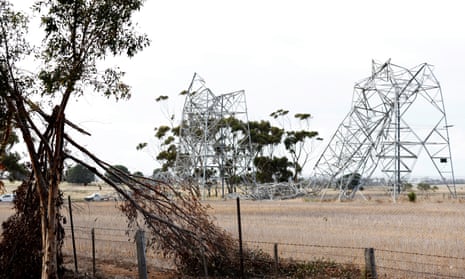Victoria’s energy minister will push for a national approach to weatherproof the electricity grid, with about 77,000 properties still without power after a deadly storm brought down transmission lines.
Lily D’Ambrosio said the storm, which swept through the state on Tuesday afternoon and resulted in the death of a dairy farmer in South Gippsland, has caused “one of the largest outage events in the state’s history”.
As of 10.30am Thursday, 77,000 homes and businesses remain without power, with the majority located in the state’s east, according to the Department of Energy, Environment and Climate Action.
D’Ambrosio has stressed the need to make the country’s electricity grid more resilient given climate change was leading to more extreme weather events.
“I’ve also put on the agenda, nationally, the need for us to actually have a system-wide understanding, appreciation and a set of solutions,” D’Ambrosio told reporters from the state control centre on Wednesday.
“Poles and wires just don’t stop at the borders. Transmission lines don’t stop at the borders. Climate change and more frequent and extreme weather events … sadly means that we’re going to see more of that happening.
“What are the resilience measures that we need to embed in the system to ensure that we are better prepared, communities are better prepared, for such events?”
Guardian Australia understands D’Ambrosio met with the Australian Energy Regulator, which oversees the transmission network service, to discuss the issue on Wednesday afternoon.
It will also likely be raised when state and federal energy ministers meet in Canberra on 1 March. It is understood a subcommittee of ministers have been working with the Australian Energy Market Operator (Aemo) on grid resilience for several months.
A spokesperson for the federal energy minister, Chris Bowen, agreed it was critical to improve the grid.
“We’re experiencing more frequent and more severe extreme weather events due to the changing climate,” the spokesperson said.
“This shows how critical a resilient and modern grid is to give network operators multiple options for rapidly diverting electricity around different parts of the grid and between states as needed.”
The number of outages are down from a peak of 530,000 on Tuesday.
Power outage update:
— Lily D'Ambrosio MP (@LilyDAmbrosioMP) February 14, 2024
As at 6pm, there are 120,917 customers off power, 2,791 of these are power dependent customers.
My thoughts are with everyone affected by this unprecedented, catastrophic weather event.
Aemo said electricity network crews were working to clear and repair damaged powerlines and poles but given the extend of the damage it may take “days if not weeks” to restore power to all those impacted.
AGL has also worked to restart its huge Loy Yang A power station in the Latrobe Valley after the generator “tripped” – automatically shutting down its four units – when six high-voltage towers on the Moorabool-Sydenham transmission line in Anakie, near Geelong, were knocked down during the storm.
At the time, Aemo switched off electricity to about 90,000 consumers, largely near the Keilor area, as a “last resort to return the power system to a secure operating state”.
after newsletter promotion
At Wednesday’s press conference, D’Ambrosio stressed most outages were due to storm damage to the transmission system rather than any shortage of supply.
“[Tuesday] was not about a lack of electricity supply,” she said, comparing the state’s electricity supply to a car full of petrol but with “no road to travel on”.
“It’s got the power and the supply but you can’t take it to where you want it to go.”
Regardless, the opposition have sought to blame the outages on the Allan Labor government’s failure to “plan the transition to renewable energy properly”.
The opposition energy spokesperson, David Davis, said six towers on the same transmission line collapsed due to storms in 2020. A review by Energy Safe Victoria recommended they be replaced with towers that could withstand high-intensity winds.
“The state government knew four years ago that those kinds of downdrafts could knock out six towers. The pictures look extraordinarily similar,” Davis said.
“The state government appears not to have dealt with the lessons from 2020, their own review, and they appear not to have provided a solution for resilience into the broader system.”
He said Victoria’s transmission network consisted of structures originally designed between the 1960s and 1980s.
The Greens, meanwhile, have called on AGL, Energy Australia and Alinta, which own Victoria’s three coal-fired power stations, to pay for recovery efforts.
“It’s time to hold Victoria’s big coal polluters to account. They caused this mess, now they can pay to clean it up,” Greens MP Tim Read said.
“There’s no better way to incentivise energy corporations to switch from coal to renewables than making them pay for the escalating climate damage.”
